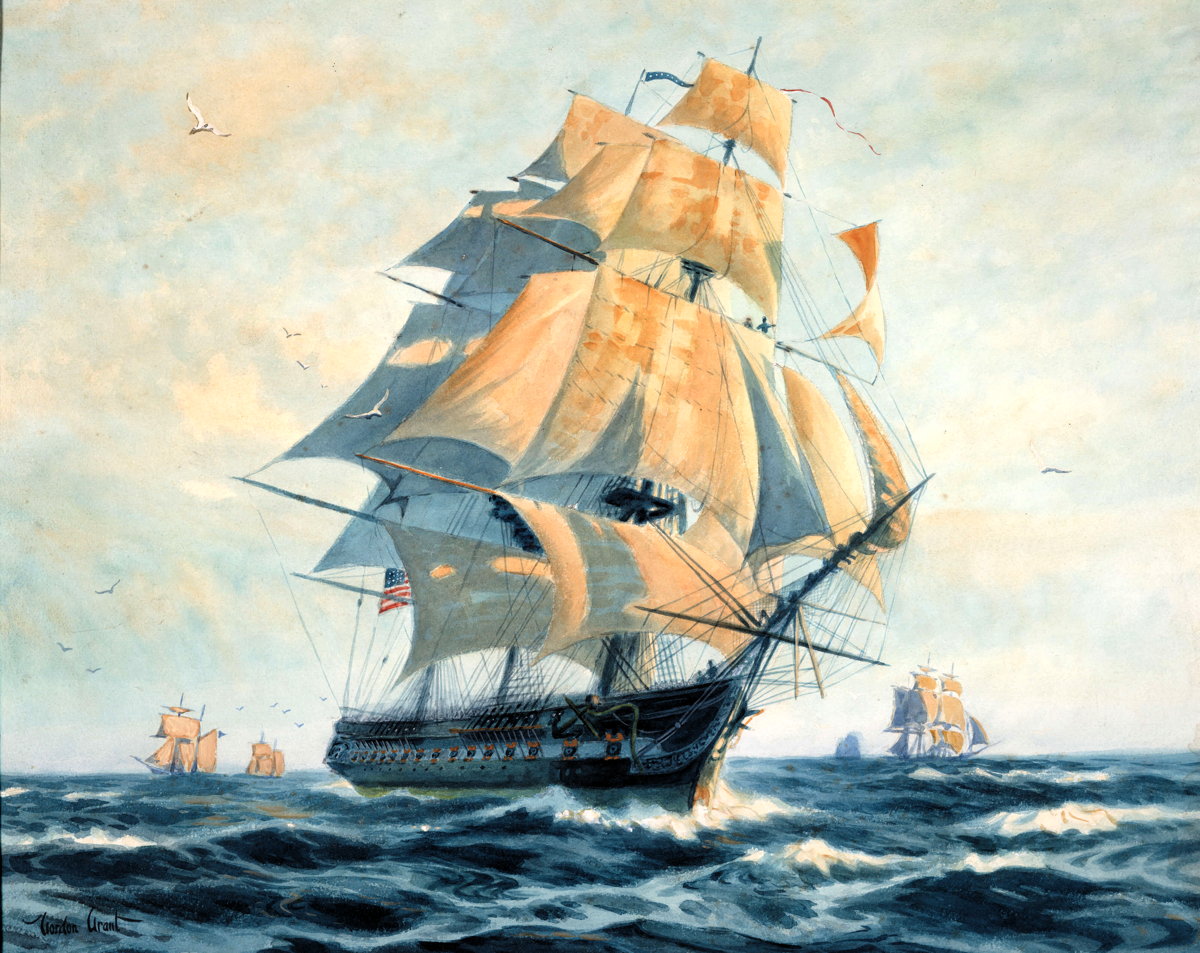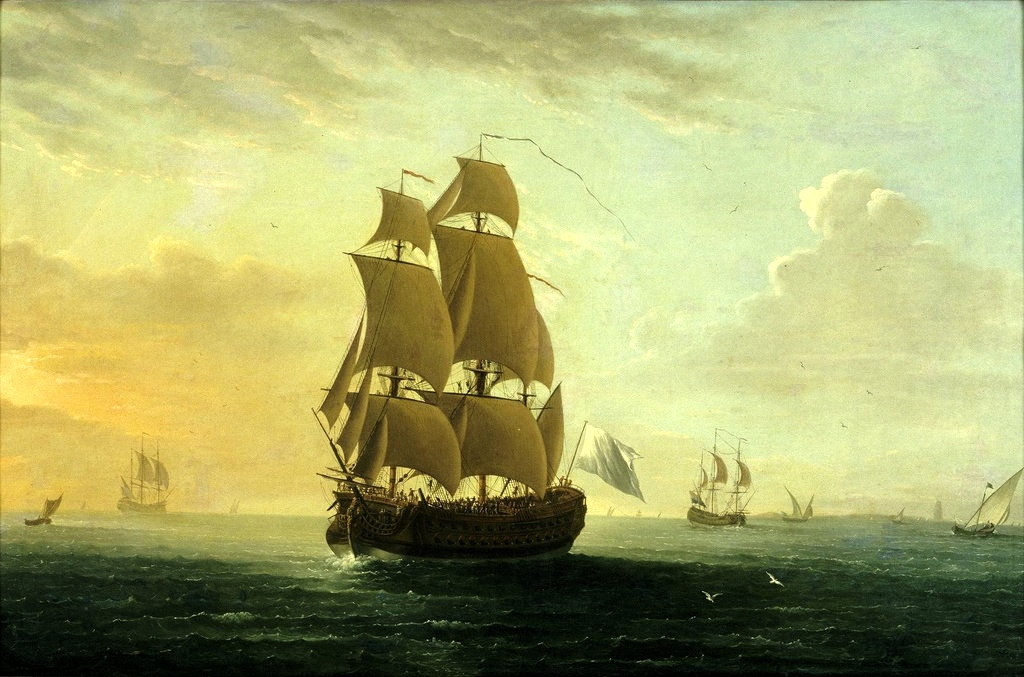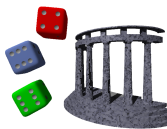L’Entreprenante l’Entreprenante: Mirror Universe Trek for Flashing Blades

This 1927 painting by Gordon Grant in the USS Constitution Museum depicts the USS Constitution. It’s very similar to what l’Entreprenante would look like.
I ran a second game of Flashing Blades at North Texas in June. It was a blast. The idea was that the crew of the mirror universe Star Trek from the Mirror, Mirror episode were stuck on a 1705 French warship (PDF File, 2.6 MB) until they could right the timeline to restore the Enterprise from whatever their own meddling in time had done to it.
Much as the Federation timeline crew had to do in City on the Edge of Forever. In fact, I incorporated that episode into the history of the Mirror Universe, but my fictional Mirror Universe crew had instead had to ensure peace activist Edith Keeler’s survival rather than her death.
I incorporated the High Seas supplement into the adventure, but I didn’t realize what that meant until I, fortunately, ran a test of the adventure with my local group. Given the backstabbing, power-hungry nature of the Mirror Universe crew I expected lots of sword fights, both between the Enterprise and l’Entreprenante crews and among the ambitious Enterprise crew.
In fact, the draw of this game was the ship combat. After running the first game locally, I added a simple ship-to-ship combat at the beginning of the game against a weaker ship as a likely possibility. This contrasts with a more dangerous ship-to-ship combat at the end of the game against a stronger ship. It also gives the players a handle on how ship combat works in Flashing Blades before the big fight at the end of the adventure.
This change also made the 18th century crew more active with respect to the 23rd century crew.
After the playtest I also modified one aspect of High Seas combat. High Seas provides five ship ranges: Far, Long, Medium, Short, and Close. This means that chases are over much too quickly. I added Too Far (which provides two ranges that are too far for firing cannon) as well as Medium Long and Medium Short. This gives more time for ship-to-ship volleys, especially where both ships are bearing down on each other.
I’ve updated the rules summary sheet (PDF File, 130.1 KB) to include a summary for High Seas ship-to-ship combat. This summary includes both the canonical ranges and my extended ranges.
Ship-to-ship combat in Flashing Blades is very simple; your range and your action (one of Evasion, Bear Down, and Circle) determines which cannon you can fire, whether front cannons, rear cannons, or broadsides. You can fire at either the rigging or the hull, which will affect how a ship is disabled and how useful it is if disabled. That’s pretty much it for combat, although, being an old-school game, there are calculations involved with determining damage done by a barrage of cannons.
As part of importing the Star Trek crew into the game, I have a few new options for player characters (PDF File, 23.2 KB). I added a new Starting Background, the Scholar. While I added the scholar for the Star Trek characters such as Dr. McCoy and Mr. Spock, I treat this background as if it were from the seventeenth century. New skills have names as if from the seventeenth century, not the twenty-third.

While we know neither who painted this or what it is a painting of, it is likely very similar to what the Triton would have looked like.
There is one special skill for future characters, Archaic Rider. This not a skill in itself, it’s a skill that applies to other skills. A character with Archaic Rider can perform their modern skills even in archaic times or with archaic equipment. Thus, a Star Trek pilot who has Archaic Rider can also pilot a sailing ship. Without Archaic Rider, an anachronistic character is going to be lost trying to use old technology.
If you want to make Archaic Rider fit in more with the existing rules, you can make it like Literacy, that is, it must be applied separately to each specific skill.
The only skills I’ve added other than Archaic Rider are Engineering, Natural Philosophy, Physic (i.e., medicine—I’m a little surprised this wasn’t already in the rules, or at least in High Seas), and Signals. These are, you’ve probably noticed, the main characters of original Star Trek beyond the already existing Captaincy: Scotty, Spock, McCoy, and Uhura.
While the Scholar background is open to any character, I also added an additional guild open only to Federation characters: Starfleet Academy. There are two tracks to Starfleet Academy: a Civilian track (open to Scholars, Gentlemen, and Nobles) and a Military track (open to Marines, Soldiers, and Sailors). Marines and Sailors are new backgrounds from the High Seas supplement.
The crew of the Enterprise and l’Entreprenante are of course more experienced than starting characters; most of them are masters in some skill, such as being a master captain or a master pilot, or engineer, and so forth. One of the cool bits of Flashing Blades is how it handles improvement: beginners have to roll, and masters often do not. They’re masters, after all.
The adventure itself is little more than a situation. It describes three ships (including l’Entreprenante), the basic background of why the characters are there, and the pitfalls of time travel in the Star Trek universe.
It’s very open-ended, so if you end up running it you’ll definitely have to improvise a lot in response to what your players do. I actually expected more “trouble” from the Star Trek fans among the players at North Texas, but I also ended up getting a lot of Master and Commander fans at the game!
In retrospect this wasn’t surprising, but it meant some very fast thinking required on my part to react to the tactics imported from those books. I strongly recommend reading at least the first Master and Commander, and probably the first three, if you choose to run this adventure outside of your circle of friends. Presumably you already know whether your friends are going to lean to the Trek side or the age of sail side.
I’ve made four PDFs available: the adventure (PDF File, 2.6 MB), the updated rules summary (PDF File, 130.1 KB) (which includes the dueling aid), the new background and academy (PDF File, 23.2 KB), and the pregenerated player character archive (Zip file, 10.8 MB). The latter also includes a page of 4x6 Captain’s Cards that outline the stats on each of the three ships.
The Three Decks web site was very useful for looking up stats for ships of the era.
In response to Dueling aid for Flashing Blades: Dueling is one of the many fun aspects of the Flashing Blades RPG. This dueling aid will help players choose their opponent, their two actions, and their parrying guess.
downloads
- l’Entreprenante l’Entreprenante (PDF File, 2.6 MB)
- “The Guardian of Forever. Mirror Universe Trek. The Golden Age of Piracy. The Imperium’s research into the Guardian has destroyed the Enterprise and the Imperium. Righting the timeline requires braving the high seas and… flashing blades!”
- Dueling aid for Flashing Blades
- Dueling is one of the many fun aspects of the Flashing Blades RPG. This dueling aid will help players choose their opponent, their two actions, and their parrying guess.
- Flashing Blades rules summary (PDF File, 130.1 KB)
- This outlines the important Flashing Blades and High Seas rules for game masters who have the rulebooks.
- Flashing Stars character sheets (Zip file, 10.8 MB)
- Character sheets for the pregenerated characters in the Mirror Universe/Flashing Blades mashup.
- Scholars and Space Academy for Flashing Blades (PDF File, 23.2 KB)
- A new background (scholars) and guild for Flashing Blades and the High Seas supplement, for adding scholars and for mashing up with Star Fleet.
Flashing Blades
- Flashing Blades: Mark Pettigrew at Fantasy Games Unlimited
- “It was a question of honor, and honor was always foremost in the minds of the men who strode through the age of the Sun King. A deserted courtyard on the edge of Paris was the stage on which they met with… FLASHING BLADES.”
- Flashing Blades at North Texas, 2025
- I’ll be running Flashing Blades again at North Texas this year, in a game called l’Entreprenante l’Entreprenante, pitting 1705 Naval officers against 23rd century Mirror Universe Imperial Officers.
sailing
- Flashing Blades: High Seas: Mark Pettigrew at Fantasy Games Unlimited
- “An expansion for FLASHING BLADES to allow characters to adventure in the New World and at sea… complete rules for the creation of colonial characters, new skills and backgrounds for the New World, a complete background to the New World and the colonial bureaucracy, colonial military campaigns, and… complete rules for shipbuilding, ship types, sea travel and trade, and ship-to-ship combat.”
- Review: Master and Commander: Jerry Stratton at Jerry@Goodreads
- You could probably learn sailing from this book, which follows Jack Aubrey’s command at the cusp between naval service as high-seas adventure and modern naval operations.
- Three Decks—Warships in the Age of Sail
- “Three Decks has grown to become the premier web resource for researching naval history during the Age of Sail. Three Decks features detailed information on vessels, crew, shipyards, dockyards, naval actions, geographical locations and much, much more including background details on the ranks, appointments and the nations involved.”
More adventures
- The Adventure Guide’s Handbook
- Weave fantasy stories around characters that you and your friends create. As a Gods & Monsters Adventure Guide you will present a fantastic world to your players’ characters: all of its great cities, lost ruins, deep forests, and horrendous creatures.
- Adventure release: House on Crane Hill
- Some houses were born evil: an adventure for first-level Gods & Monsters characters, designed specifically for convention games but fun for all.
- Far Out, My Idol: A Kolchak adventure for Daredevils
- Carl Kolchak and guest stars investigate the infamous high-rise murders during Chicago’s record freeze of January, 1977.
- Kolchak: The Wrong Goodbye (a Daredevils adventure)
- Kolchak and crew investigates strange murders during the 1976 Christmas season. Inspired by “real” Soviet research as reported in UFO magazines of the era.
- Kolchak: The Big Creep (a Daredevils adventure)
- Inspired by The Powers of Dr. Remoux, The Big Creep is a Daredevils adventure for The Night Stalker set in the autumn of 1976.
- 17 more pages with the topic adventures, and other related pages
More Flashing Blades
- Flashing Blades: Character Calculation Perl Script
- Needing a bunch of characters quickly, I wrote a Perl script to do the basic rolls and basic calculations, with an option for creating more experienced characters.
- Flashing Blades: En coulisse de l’Hôtel de Bourgogne
- Can you retrieve stolen French naval secrets before your rivals? A simple convention-style reskin of a classic Flashing Blades adventure.
- Flashing Blades at North Texas, 2025
- I’ll be running Flashing Blades again at North Texas this year, in a game called l’Entreprenante l’Entreprenante, pitting 1705 Naval officers against 23rd century Mirror Universe Imperial Officers.
- Dueling aid for Flashing Blades
- Dueling is one of the many fun aspects of the Flashing Blades RPG. This dueling aid will help players choose their opponent, their two actions, and their parrying guess.
- Flashing Blades at NTRPGC 2024
- I’ll be running a game of Flashing Blades on Wednesday at North Texas 2024.
More Star Trek
- Flashing Blades at North Texas, 2025
- I’ll be running Flashing Blades again at North Texas this year, in a game called l’Entreprenante l’Entreprenante, pitting 1705 Naval officers against 23rd century Mirror Universe Imperial Officers.
- The Star Trek Experience: Stanley Jaffe was right
- In 1992, Paramount executive Stanley Jaffe single-handedly killed an audacious, innovative, one-in-a-million Las Vegas attraction. Because that’s what he was hired to do.
